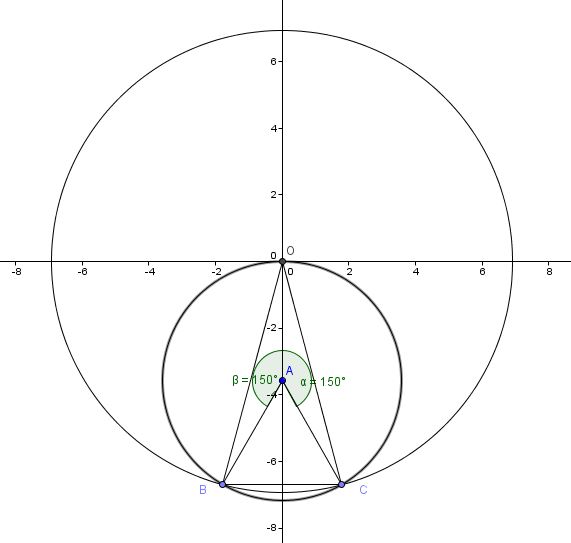Look at the following diagram to get a feel for this :

The larger circle will have the equation
x^2 + y^2 = 48
Since A will be the circumcenter for BOC.....then the distance from A to O will be the same distance as from A to B and from A to C
And since ABC is equilateral, then BAC = 60°
Then major angle BAC = 300°
And using symmetry, angle OAC = 150°
But AO = AC....so...triangle OAC is isosceles.... and angle AOC = 15°
And since OC is a radius of the larger circle it equals √48
So......we can find a side of the equilateral triangle - AC - thusly
OC / sin (OAC) = AC/ sin (AOC)
√48 / sin (150) = AC / sin (15)
AC = √48sin (15) / sin (150) =
AC = √48 ( sin (45 -30) / (1/2) =
2√48 (sin45sin30 - sin30cos45) =
2√48 (√2√3 / 4 - √2 / 4) =
√48/2 (√6 - √2 ) =
2√3 ( √6 - √2 )
√12 ( √6 - √2) =
√72 - √24 =
6√2 - 2√6 (exact value)
Then the equation for the circle with A as a center passing through the vertices of BOC is
x^2 + (y^2 +6√2 - 2√6)^2 = ( 6√2 - 2√6)^2
And the area of equilateral triangle ABC = (√3 /4)s^2 =
(√3/4) (6√2 - 2√6)^2 =
(√3 / 4) ( √72 - √24) =
(√3/ 4) ( 72 - 2 √(72*24) + 24) =
(√3/ 4) ( 96 - 2√1728) =
(√3/ 4) (96 - 48√3) =
12√3 ( 2 - √3) =
24√3 - 36 units ^2 ≈ 5.57 units^2


